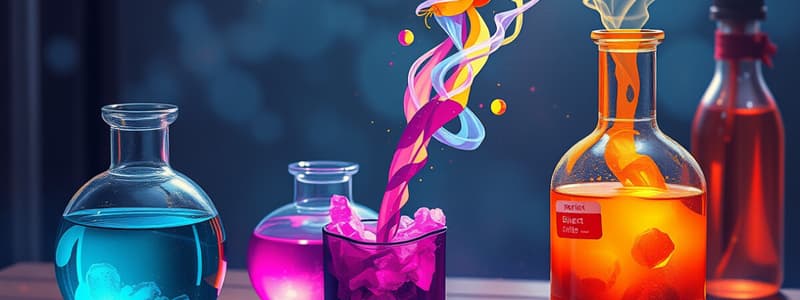Podcast
Questions and Answers
Why are proteins the most important food stuff?
Why are proteins the most important food stuff?
Animal tissues are made up of proteins. Proteins serve as the structural materials for animals as the polysaccharides do for plants.
What is indicated by a positive color reaction with the Biuret test?
What is indicated by a positive color reaction with the Biuret test?
Presence of peptide linkage
What is indicated by a positive color reaction with the Ninhydrin test?
What is indicated by a positive color reaction with the Ninhydrin test?
Presence of alpha amino acid
What is indicated by a positive color reaction with the Xanthoproteic test?
What is indicated by a positive color reaction with the Xanthoproteic test?
What is indicated by a positive color reaction with Millon's test?
What is indicated by a positive color reaction with Millon's test?
What is the building block of all proteins?
What is the building block of all proteins?
What color do proteins produce in the Biuret test?
What color do proteins produce in the Biuret test?
Which of the following tests detects the presence of indole nucleus in proteins?
Which of the following tests detects the presence of indole nucleus in proteins?
Match the following tests with their purpose:
Match the following tests with their purpose:
Study Notes
Color Reaction Tests for Proteins
- Biuret Test: Detects proteins and substances with peptide linkages; positive result indicates hydrolysis completion. Reaction: Protein + NaOH + dil. CuSO4 produces violet color.
- Xanthoproteic Reaction: Tests for presence of benzene ring in proteins. Reactions with concentrated HNO3, NaOH, and NH4OH yield yellow, red, and orange colors respectively.
- Millon’s Test: Identifies phenolic -OH groups in proteins. Reaction with Millon’s reagent produces a red precipitate if present.
- Hopkin's Cole Test: Specific for indole nucleus in proteins; reveals presence of tryptophan. Reaction with glycocyclic acid and H2SO4 results in reddish violet ring.
- Ninhydrin Reaction: Tests for alpha amino acids; produces blue violet to red violet color upon reaction with alpha-amino acid.
Results Observations
-
Action of Heat:
- Egg albumin forms cloudy mixture with white solids.
- Gelatin solution undergoes coagulation.
-
Action of Metal Salts:
- Albumin solution develops white precipitate upon reaction.
- 2% HgCl2 creates a cloudy solution.
- 0.1 M NaCl results in white precipitate formation.
- 1% AgNO3 induces a specific precipitate.
-
Action of Picric and Tannic Acid:
- Albumin yields yellow green precipitate with picric acid and brown precipitate with tannic acid.
- Gelatin shows no precipitation with either acid.
-
Action of Ethanol:
- 95% alcohol creates a very cloudy mixture with white precipitate using egg albumin.
- Mixture becomes less cloudy with incremental water addition.
-
Action of Strong Acids:
- Albumin and gelatin do not produce precipitate with concentrated HCl, HNO3, or H2SO4.
Buffering Action
- Phenolphthalein + 3M NaOH: Results in purple solution which persists after albumin addition.
- Methyl Orange + 3M HCl: Produces red solution which remains after albumin addition.
Color Reactions
- Biuret Test: Egg albumin gives violet color with coagulation, while glycine results in blue violet solution.
- Ninhydrin Test: Albumin and tryptophan exhibit violet color; gelatin does not respond.
- Xanthoproteic Test: Albumin and tryptophan present yellowish color; gelatin is negative.
- Millon’s Test: Albumin gives crimson red mixture; gelatin and tryptophan do not react.
- Hopkin's Cole Test: Albumin forms reddish violet mixtures; gelatin shows no reaction.
Key Concepts
- Proteins are essential for life, constituting animal tissues and serving as structural materials.
- Proteins are made of amino acids linked by peptide bonds, containing C, H, O, N, and sometimes S or P.
- Important for food and occur widely in both plants (mostly in seeds) and animals (small quantities in body fluids).
- Urine and bile are the only fluids lacking proteins.
Questions and Answers
- Importance of Proteins: Foundational substance for animal tissues, analogous to structural polysaccharides in plants.
- Positive Color Reactions Indicate:
- Biuret Test: Peptide linkage presence.
- Ninhydrin Test: Alpha amino acid presence.
- Xanthoproteic Test: Benzene ring presence.
- Millon’s Test: Phenolic group presence.
- Building Blocks: All proteins are built from amino acids, represented as $H-C-COOH$ and $NH_2$.
Studying That Suits You
Use AI to generate personalized quizzes and flashcards to suit your learning preferences.
Description
This quiz focuses on various color reaction tests used to identify proteins, including the Biuret test, Xanthoproteic reaction, and Millon's test. Each test's chemical processes and the resulting colors are essential for understanding protein chemistry. Test your knowledge on the principles behind these reactions and their applications.




